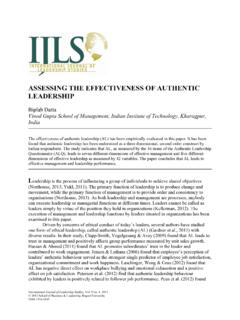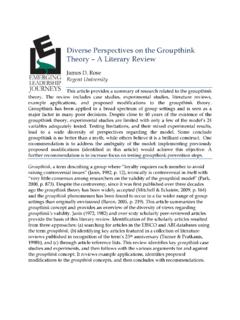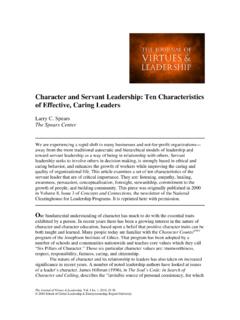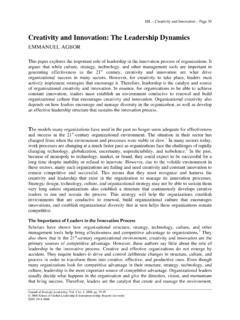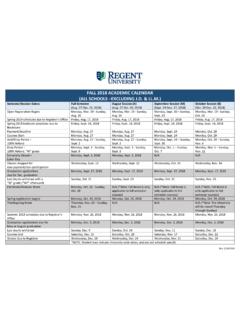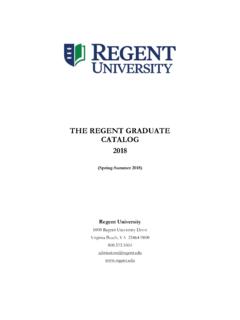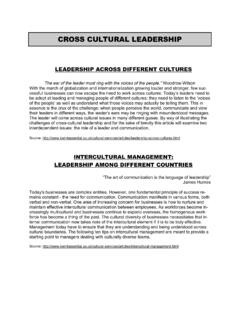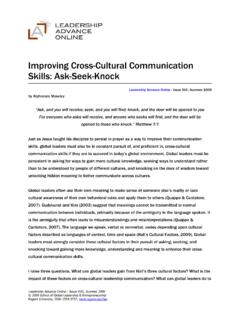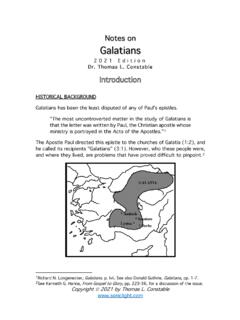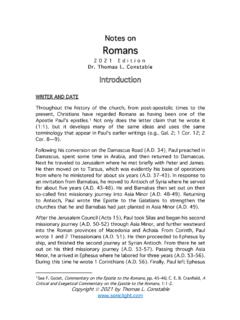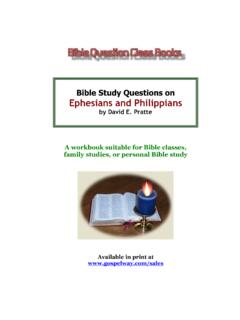Transcription of The Journal of Biblical Perspectives in Leadership
1 The Journal of Biblical Perspectives in Leadership is a publication of the Regent University School of Business & Leadership1000 Regent University Drive | Virginia Beach, VA 23464 | | ISSN 1941-4692 | 2018 Volume 8, No. 1 | Fall 2018 Journal of Biblical Perspectives in Leadership 8, no. 1 (Fall 2018). 2018 School of Business & Leadership , Regent University ISSN 1941-4692 Table of Contents FROM THE EDITOR | Joshua D. Henson 1 FEATURED ARTICLES THE TEMPLE, THE BODY, AND THE PEOPLE: ANCIENT METAPHORS FOR THE MODERN CHURCH | Carlo A. Serrano 3 WHEN SERVANT Leadership FAILS: THE IMPORTANCE OF ALIGNING VALUES | Nathan Mizzell and Russell L. Huizing 12 A STATE OF CONFUSION OR DEVELOPMENT? A META-ANALYSIS OF SERVANT Leadership IN JBPL ARTICLES | Tom Clark 25 THE MAKING OF ORGANIZATIONAL LEADERS: CASE STUDY OF NELSON ROLIHLAHLA MANDELA, MOTHER TERESA, AND WILLIAM CAREY | Tariku Fufa Gemechu 37 EMOTIONAL INTELLIGENCE IN THE DISCOURSE OF THE JOHANNINE ACCOUNT | Jake Aguas 51 JOHN 9: THE BLIND MAN TRANSFORMED | Matthew B.
2 Thrift 71 Leadership OF JESUS REVEALED IN THE GOSPEL OF JOHN | Daniel W. Keebler 89 INNER TEXTURE ANALYSIS OF PSALM 91: THE ENHANCEMENT OF TRANSFORMATIONAL Leadership THEORY | Matthew F. Viau 99 Journal of Biblical Perspectives in Leadership 8, no. 1 (Fall 2018). 2018 School of Business & Leadership , Regent University ISSN 1941-4692 PAULINE Perspectives OF Leadership THRIVING IN ADVERSITY: THE ORGANIZATIONAL STRATEGY THAT TRANSFORMED A CITY | Steven E. S. Bussey 114 STEWARD Leadership AND paul | Jeremy Kamer 126 PAULINE Perspectives ON RELIGIOUS CONSECRATION, RELATIONAL RECONCILIATION, AND SPIRITUAL TRANSFORMATION | Benjamin Crisp 136 FOLLOWER DEVELOPMENT: paul S CHARGE TO TIMOTHY | Suzana Dobric Veiss 150 TITUS 2:1-10: TRAIT THEORY OF FOLLOWERSHIP | Sarah Rolle 168 THE ROLE OF Biblical VALUES IN THE DEVELOPMENT OF THE MISSION AND VISION OF ETHICAL ORGANIZATIONS: AN EXAMINATION OF THE epistle OF TITUS | Joshua D.
3 Henson 186 AUTHENTIC Leadership : paul S INSTRUCTIONS TO TITUS | Beth L. Wilson 202 INTELLECTUAL DISCOURSE AS A METHOD OF SAINT paul S TRANSFORMATIONAL Leadership : A SOCIO-RHETORICAL ANALYSIS OF ACTS 17-19 | Chad H. Newton 213 SOCIAL AND CULTURAL TEXTURES IN GALATIANS 1 | Keith Maynor 226 INTERGROUP CONFLICT AND SOCIAL IDENTITY IN GALATIANS: AN EXEGETICAL ANALYSIS | Elizabeth K. Hunt 236 FOSTERING UNITY WITHIN A GLOBAL ORGANIZATION | Melva B. Robertson 248 A SOCIO-RHETORICAL ANALYSIS OF ROMANS 14:13-23: A DISCUSSION OF ETHICAL Leadership | Elizabeth K. Hunt 256 ROMANS 12:3-8 AND AUTHENTIC Leadership | Neal Anderson 267 Leadership AS PARTICIPATION IN CHRIST: paul S THEOLOGY OF Leadership IN THE LETTER TO THE PHILIPPIANS | Karl Inge Tangen 276 HOW THE CHRIST HYMN IN PHILIPPIANS 2:5 11 INFORMS THE PRAXIS OF Leadership IN AT-RISK COMMUNITIES: TWO SUPER-LEADERS OPERATIONALIZING KENOSIS | J.
4 Randall Wallace 291 Journal of Biblical Perspectives in Leadership 8, no. 1 (Fall 2018). 2018 School of Business & Leadership , Regent University ISSN 1941-4692 From the Editor Joshua Henson, Regent University School of Business and Leadership On behalf of the Regent University s School of Business and Leadership and the editorial board of the Journal of Biblical Perspectives in Leadership , I thank you for support on the Journal . This issue continues to broaden the horizon of exegetical-based research in organizational Leadership in both scope and research methodology. The theme of this issue is Pauline Perspectives of Leadership . Some of the highlights in this issue include multiple articles on servant Leadership ; an in-depth examination of organizational strategies for bringing transformation; multiple articles on the Pastoral Epistles; and finally, an examination of followership from a Biblical perspective.
5 We remain grateful for the support and guidance from our esteemed reviewers and the visionary support of Dr. Gomez and Dr. Winston at the School of Business and Leadership at Regent University. Grace and peace in the name of Jesus Christ. Journal of Biblical Perspectives in Leadership 8, no. 1 (Fall 2018). 2018 School of Business & Leadership , Regent University ISSN 1941-4692 The Editorial Board Representing a diverse group of scholars in Biblical , social-science, historical and Leadership studies, from around the world, the JBPL editorial board aims to provide a much needed multi-disciplinary, as well as international perspective on current research and interest in Biblical Perspectives in the study of Leadership . Each member of the editorial board has been selected because of their published research and focused interest in the exploration of Leadership within the Christian Scriptures and its application in the many varied contexts around the world.
6 To contact the editorial staff, please send an email to Editor Dr. Joshua Henson Regent University Reviewing Members Dr. Steven Crowther Grace College of Divinity Dr. Mike Mahan Regent University Dr. J. Andrew Wood, Jr. Regent University Dr. Russell Huizing Toccoa Falls College Dr. Dave West Regent University Dr. Carlo Serrano Regent University Dr. Timothy Brubaker Skokie Valley Baptist Church Dr. Dave Winner Regent University Dr. Debra Dean Regent University Production Staff Dr. Doris Gomez Dean, School of Business and Leadership Dr. Bruce Winston Program Director, in Organizational Leadership Program Journal of Biblical Perspectives in Leadership 8, no. 1 (Fall 2018), 3-11. 2018 School of Business & Leadership , Regent University ISSN 1941-4692 THE TEMPLE, THE BODY, AND THE PEOPLE: ANCIENT METAPHORS FOR THE MODERN CHURCH Carlo A.
7 Serrano The modern church is diverse in both orthodoxy and orthopraxy. However, church growth models and church health metrics seem to only apply to certain types of ecclesial expression. The Sacred Text employs a wide variety of metaphors to depict the Church. These metaphors may offer insight into the Biblical standards for ecclesial composition and praxis. This article explores various Biblical metaphors for the church and the implications those metaphors have for ecclesial life, health, and growth metrics. I. INTRODUCTION For many, Sunday in America is Church Day. Across the nation, tens of thousands of congregations gather to sing, pray, fellowship, and read the Sacred Text. One could argue that these activities are the primary functions of the church. However, a closer look at the variety of ecclesial expressions on any given Sunday reveals a complex network of churches, all with different operating systems and definitions of what church should look like.
8 If the church is so diverse in practice, how can ecclesial leaders measure church life, health, growth, and effectiveness? This article suggests that the solution may be found within the Biblical metaphors for the Church. The use of metaphor in theoretical research implies a particular way of thinking and seeing that allows one to envision the similarities between two seemingly different objects or For example, Vondey s metaphor of the Church as a People of Bread takes the image of a food staple beyond the Lord s Supper and applies it to social justice, 1 Gareth Morgan. Images of Organization (California: Sage, 2006), 4-5. Serrano/ Journal OF Biblical Perspectives IN Leadership 4 Journal of Biblical Perspectives in Leadership 8, no. 1 (Fall 2018), 3-11. 2018 School of Business & Leadership , Regent University ISSN 1941-4692 ecumenism, hospitality, and Likewise, Beale s metaphor of the Church as The Temple challenges the paradigms surrounding the sacredness of space by juxtaposing the Hebrew temple with the cosmos, the earth, and the human Metaphors such as Vine, Machine, Body, Bread, and People all have deep implications for organizational design, praxis, and growth metrics within the church.
9 II. ECCLESIAL METAPHORS An example of the power of metaphor in ecclesial design is the megachurch. A megachurch is a church that has at least 2,000 weekly attendees, a full-service ministry approach, and a large full time and volunteer Megachurches are also known for their technology driven weekend services or experiences .5 All of the aforementioned depend on some of the same structures and systems often found in large corporations. One could argue that the building-centric mentality of some megachurches creates a sacredness of space reminiscent of the Israelite temple. However, megachurch does not necessarily equal machine. Mechanistic organizations function best in stable environments where change is easily A brief foray into ecclesial ministry quickly reveals that stable is oftentimes a myth at best. As opposed to the informal routine and structure of the machine, Vondey and Beale s metaphors emphasize the living , breathing , and spreading elements of the Church.
10 As the temple, the church is to expand the Glory of God as the water covers the As a people of bread, the church is to bring life, love, and community to those within and outside of the The Temple As the temple, the Church represents the dwelling place of God and the presence of the Holy Spirit on Truly, the Church (temple) transcends brick and mortar and stained-glass images. From the beginning, God charged spiritual leaders to keep and expand his In the Old Testament, this charge referred to the physical Tabernacle and subsequent temples, which stood as earthy manifestations of 2 Wolfgang Vondey. People of Bread: Rediscovering Ecclesiology (New York: Paulist Press, 2008), 300- 304. 3 Beale. The Temple and the Church s Mission: A Biblical theology of the dwelling place of God (Illinois: Intervarsity Press, 2004), 398-402.
